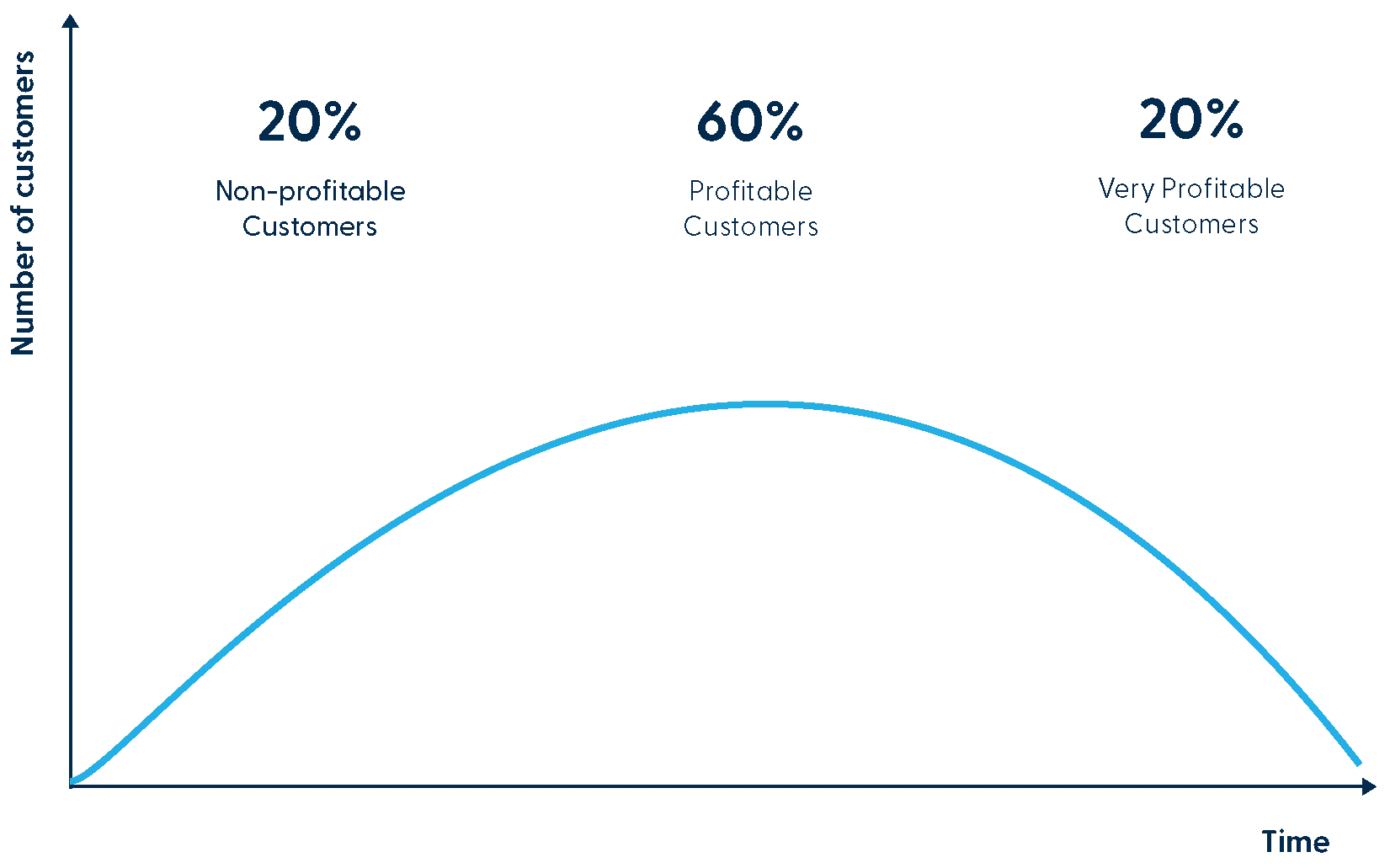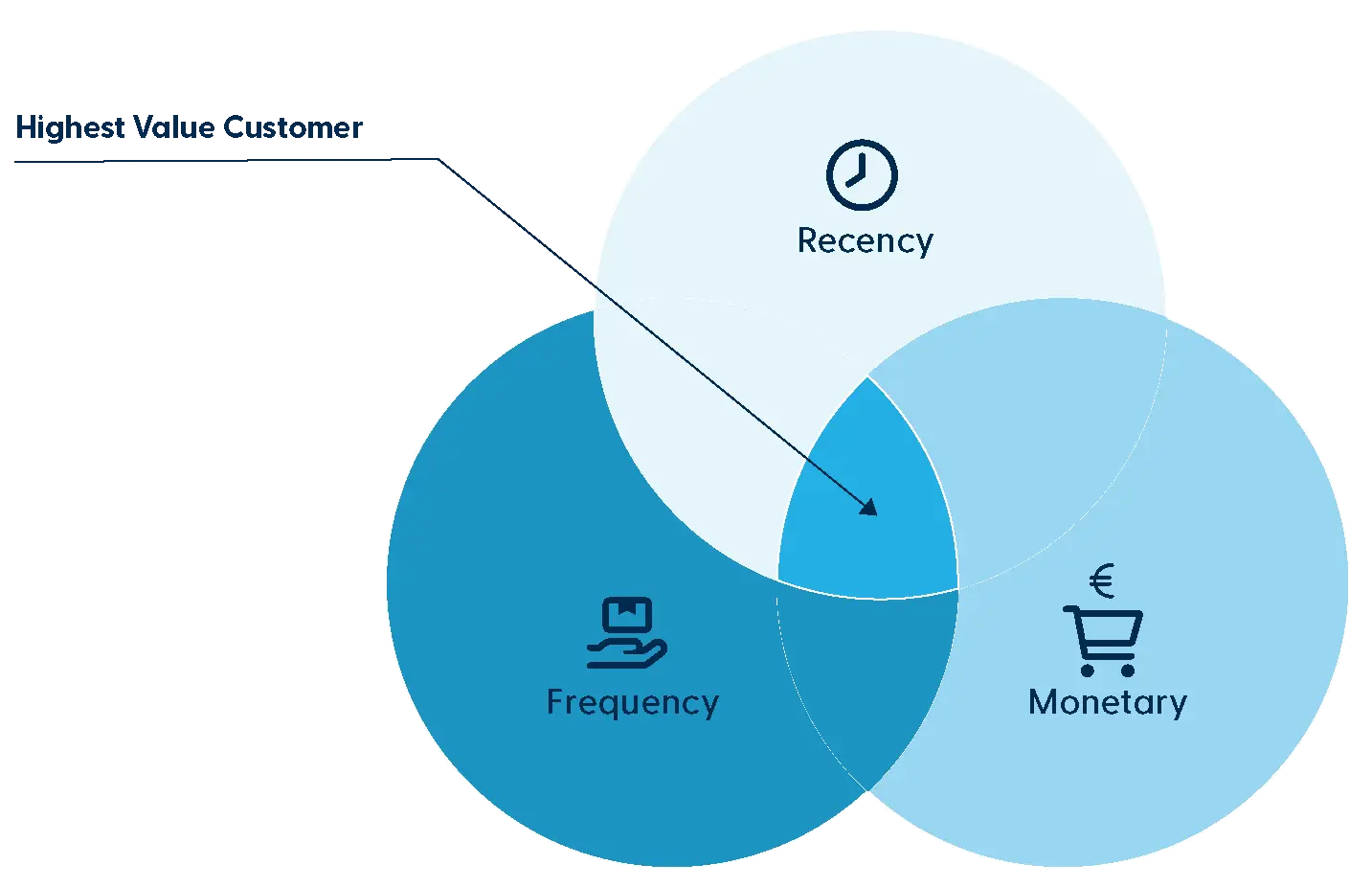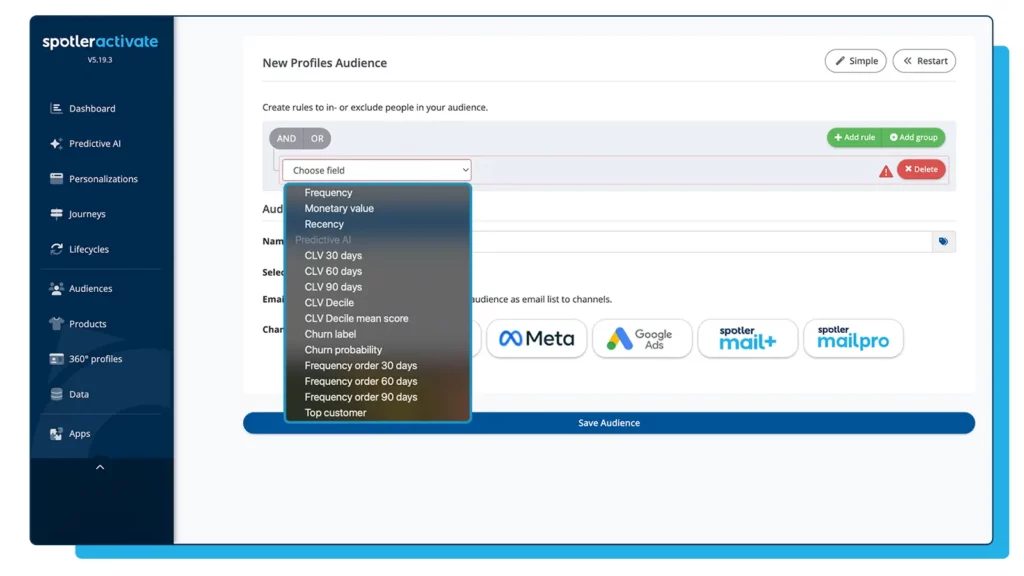Table of contents

Optimise your Customer Lifetime Value with Predictive AI
In the world of eCommerce, success revolves around understanding and responding to customer behaviour. Reaching the right audience and increasing your customer value is a profitable strategy. The success of your online shop depends not only on attracting new customers but also on maintaining and expanding relationships with existing ones.
Substantial marketing budgets are often allocated to acquiring new customers, but true profitability usually comes after multiple purchases. Predictive AI (Artificial Intelligence) can help you identify your online shop’s most valuable customer segments by predicting future customer behaviour, enabling data-driven insights and intelligent automation.
This guide delves into effectively leveraging predictive AI within your marketing strategy. It explains how to segment customers using the RFM model based on purchase history and shows how predictive AI can significantly enhance this approach by analysing historical data and forecasting future purchasing behaviour. Curious to see how predictive AI, the RFM model, and Customer Lifetime Value (CLV) can be practically applied? Read on to discover how to optimise your marketing strategy, improve your Return on Investment (ROI), and make smarter data-driven decisions with predictive AI.
Customer Lifetime Value
Customer Lifetime Value is a term that frequently arises in eCommerce marketing. You’ve likely encountered it before, but here’s a quick refresher. Customer Lifetime Value, often called CLV, refers to the total revenue a customer generates for a brand over the entire relationship duration. In other words, it’s the total income your business can expect to earn from a customer while they remain engaged with you.
Determining CLV helps you identify your most valuable customers, enabling you to allocate your marketing budgets more effectively. Once you understand this, you can segment your customers and focus your marketing efforts on those with the highest profit potential. This ensures more efficient resource allocation, targeted campaigns, and a higher ROI.
Logical, isn’t it? Unfortunately, it’s often less straightforward in practice. How do you calculate CLV? And once you’ve calculated, what do you do with it?

The RFM-model
A common method to calculate CLV is the RFM model, a data-driven segmentation technique that evaluates customers based on three key factors: Recency, Frequency, and Monetary value.

Recency refers to how long it has been since the customer’s last purchase. This helps you estimate how active and engaged the customer is. Frequency measures the number of repeat purchases within a specific period, indicating the customer’s loyalty to your brand and the consistency of their buying behaviour. Monetary, as the name suggests, focuses on how much money the customer spends.
Using these criteria, you can segment customers based on their purchase history. While highly valuable, this approach requires processing large volumes of transactional data, often using complex RFM models developed by data scientists. Fortunately, predictive AI now allows this process to be faster, simpler, and even more extensive.
Data analysis with predictive AI
AI enables the rapid processing and analysis of large datasets far beyond human capability. Predictive AI takes it a step further; it focuses on forecasting future events or behaviours, not through a crystal ball but by analysing historical data to uncover patterns.
Predictive AI uses machine learning algorithms to detect patterns in your transaction history, eliminating the need to build a complex RFM model yourself. These patterns can provide valuable insights, such as predicting buying behaviour, analysing trends, or identifying valuable customer segments for your business.
Moreover, these algorithms continually update with new data. As new purchases and behavioural data are collected, predictions are refined and more accurate, taking your analysis to the next level by incorporating future behaviour.
Predictive AI in eCommerce
Suppose you’ve applied predictive AI to your customer data and transaction history to conduct an RFM analysis and determine your CLV. Great! Now what? In the long term, predictive AI helps you identify which customer groups are worth investing in, based on their CLV.
In the short term, it helps pinpoint customer segments that can be persuaded to purchase, enabling you to allocate your marketing efforts more effectively. For practical application, you can segment your customer base into “high,” “medium,” and “low” categories. Predictive AI can automate this process and even generate contact lists for each segment.

High
Customers with a predicted high value are your VIPs. With a high expected CLV (Customer Lifetime Value), these customers benefit from premium offers and exclusive content. They are ideal candidates for upsell, cross-sell journeys, or even loyalty programmes. Strengthen their connection to your brand and aim to increase their spending per order.
Medium
These are customers with a predicted medium value. They may not generate the highest revenue, but they are not entirely inactive either. Often, they can be persuaded to make another purchase with a discount or a personalised offer
Low
Customers with a predicted low value are not necessarily the most lucrative. Spending a significant portion of your marketing budget on this group might not yield a strong return, as they are less likely to spend frequently or substantially. However, with some additional discounts, you might still encourage repeat purchases.

By segmenting in this way, you can tailor your marketing actions to the predicted value of each group, achieving better results at lower costs. This approach applies not only to existing customers but also to potential future customers. Many advertising platforms, such as Meta, can target “lookalikes.”
Lookalikes
Creating lookalike segments on an advertising platform like Meta allows you to identify and target profiles similar to your existing customers. The high-value segment serves as a basis for these efforts, enabling you to create audiences with traits identical to those of your most profitable customers.
Use cases
Maximising your marketing budget and driving as much revenue as possible is the goal of every eCommerce marketer. This can be achieved by leveraging these segments effectively. Here’s how this looks in practice:
1. Increasing second purchases
On average, eCommerce businesses spend six times more on acquiring new customers than on retaining existing ones. Yet, the first purchase rarely generates significant profit. Acquiring a new customer requires substantial time, effort, and marketing budget.
Greater profitability is often achieved by encouraging an existing customer to make a second purchase. These customers are already familiar with your brand, and more importantly, you already have their data. This might include contact details, a customer profile in your CDP or CRM, or at the very least, an email address. Typically, the focus is on high-segment customers who are likely to make frequent, substantial purchases.
Predictive AI enables personalised product recommendations based on past purchases and predicted preferences. You can use this to send targeted messages, discounts, and post-purchase campaigns, as well as include product recommendations in upsell and cross-sell journeys. These tailored strategies can help boost the average order value.
Example: A customer who purchases a coffee machine could also be sent recommendations for high-quality coffee beans, stylish mugs, or a convenient milk frother. If predictive AI identifies that this customer is likely to make repeat purchases, you might consider reaching out more frequently. Similarly, for customers likely to make larger purchases, offering premium products might be worthwhile. Investing in higher-cost channels, like SMS or WhatsApp, may also be justified for these high-value customers, given the likelihood of a strong ROI.
2. Attracting new customers
As mentioned earlier, a significant portion of marketing budgets is often spent on acquiring new customers. While running ads on platforms like Google, Facebook, or Instagram is effective, it can be costly and time-intensive. To ensure a better ROI, you want to attract customers who are likely to make repeat purchases and eventually grow into high-segment customers. Predictive AI plays a key role here, particularly in leveraging lookalike segments.
If you know the customer profiles within your high-value segment, you can target potential customers with similar characteristics. This increases the likelihood that they will spend more, purchase more frequently, and return often.
Example: A clothing brand might identify that high-CLV customers tend to purchase premium jackets made of sustainable fabrics. By using this information, predictive AI can create a profile of this top segment. This profile can then be used to build a lookalike audience on Facebook or Instagram Ads, enabling you to serve targeted ads to people with similar interests and buying behaviours.
Targeted ads that resonate with your audience attract more relevant visitors to your website, reduce the cost per lead, and save both time and resources.
3. Saving on retargeting budgets
For many online shops, retargeting is a crucial part of their marketing strategy. Naturally, you want to allocate your advertising budget as effectively as possible. Discounts are a popular method of encouraging customers to make a purchase, but they also reduce profit margins. This is why they need to be used strategically.
Predictive AI can assist in this process by helping you segment customers who are highly likely to buy and those with a lower likelihood of purchase. Both groups are important. Imagine running a campaign offering a 10% discount to people who viewed a product on your website. This discount might entice them to return to your site and purchase the product. However, the outcome can differ greatly depending on the type of customer.
For low-likelihood buyers, you generate 90% of revenue that wouldn’t have been achieved without the discount. On the other hand, the discount is unnecessary for high-likelihood buyers, meaning you lose 10% of potential revenue. That’s unfortunate. Where you deploy discounts leads to very different results. Predictive AI can identify segments of customers who are likely to purchase without requiring a discount. These segments can be excluded from expensive retargeting campaigns, reducing costs without negatively impacting your revenue.
Conversely, you should focus discounts on customers with a lower likelihood of purchase, as a price reduction might encourage them to complete a purchase. By excluding frequent buyers from your retargeting campaigns, you can protect your margins and save on advertising spend, ensuring discounts are only offered to customers who genuinely need the motivation.
Conclusion
Leveraging predictive AI offers numerous opportunities to enhance your CLV and make better use of your marketing budget. Predictive AI automates customer data analysis and enables predictive insights. By segmenting your customer base based on expected value and buying behaviour, you can make targeted, data-driven decisions that improve both customer satisfaction and revenue.
By grounding your marketing strategy in data-driven insights, you increase the relevance of your campaigns, build long-term customer relationships, and boost revenue while saving on marketing costs. This not only improves ROI but also promotes sustainable growth for your eCommerce business.
Predictive AI helps identify your most valuable customers and ensures optimal allocation of your marketing budget. Whether by increasing repeat purchases, attracting high-potential new customers with lookalike audiences, or saving on retargeting campaigns. Smarter decisions, powered by predictive AI, lead to better results.
Want to learn more about how predictive AI can improve your e-commerce marketing strategy?
Schedule a demo to see Predictive AI in action. Our specialists are eager to demonstrate how AI can help your business grow.
Keep expanding your knowledge
Black Friday and Cyber Monday 2025 set new email sending records for Spotler customers
Black Friday & Cyber Monday 2025: Spotler breaks email sending records with 148 million emails.
Christmas Marketing Hub
The most joyful time of year is now. Time to set up your Christmas campaign. We got you covered with our Christmas toolkit. Everything you need for a beautiful campaign can be found in our hub.
The marketing mix Christmas wishlist
Get the most out of the biggest shopping season of the year with these top 10 tips to improve your marketing mix this Christmas!
How AI Analytics can improve your marketing in at least nine ways
Enough with the abstract theory, how can you actually get better results with AI today? This guide dives into the details of AI Analytics for marketing.
The 5 types of Black Friday customers – and how to respond to each
Loyalists, Researchers, and Impulse Buyers are all after different things from you this Black Friday. Are you set up to give it to them?
How to spot bot opens and clicks in your email statistics
The percentage of bot opens and clicks in emails is increasing. How can you recognise and extract human behaviour from your email statistics?
First-party vs. third-party data: Why it’s crucial for marketers
Discover the difference between first-party and third-party data and why first-party data is becoming indispensable for marketers in a cookie-less future.
Black Friday Marketing Hub
Stress less. Sell more. Your toolkit for turning peak pressure into sales and customer loyalty. Everything you need for a successful campaign can be found in our hub.
Black Friday 2025: 5 trends you can’t miss
Discover the most important trends for Black Friday 2025: personalisation, AI, Green Friday, and social shopping tips for maximum results.
AI marketing dashboards you can talk to
What if you could just ask your data a question and get an immediate answer in plain words, like a colleague would. That is possible now. Find out how!
